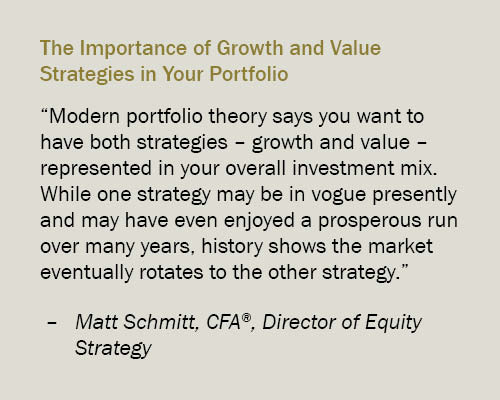3 min read
‘Growth’ or ‘Value’: Which Style Is Best for Your Portfolio?
 Matt Schmitt, CFA® Senior Vice President, Director of Equity Strategy
:
Feb 22, 2023 7:00:00 AM
Matt Schmitt, CFA® Senior Vice President, Director of Equity Strategy
:
Feb 22, 2023 7:00:00 AM

Each new year affords us a chance to revisit fundamental investing concepts we often lose sight of or take for granted.
For example, you or your financial advisor likely have some of the stock investments in your portfolio divided between “growth” and “value” for prudent diversification. But why are these allocations to these two buckets considered fundamental to sound portfolio management?

Let’s review the definitions of growth and value and why they represent the yin and yang in an investment portfolio.
Growth investing
Growth investing focuses on companies whose business models are geared for rapid expansion and are expected to grow sales and earnings at a rate faster than the market average. Likely they have a competitive advantage with a new product or service in a new or rapidly growing industry. To capture this advantage, these companies plow profits back into their businesses (e.g., new equipment, acquisitions, personnel) and are not as concerned about dividends while they maximize their customer reach.
Companies in this category often are able to grow at a pace faster than the broader economy — another reason for the “growth” label. By nature, growth stocks can be riskier and can experience stock price swings triggered if that product or service misses the mark and the anticipated growth does not materialize.
Value investing
Value investing, on the other hand, focuses on companies whose stock prices don’t necessarily reflect their true current worth when measured by fundamentals such as revenue, earnings, or profit margins. Sometimes these are more mature businesses that are more reliant upon overall economic growth to grow their revenue and earnings, which are trading at share prices considered a bargain.
Often this happens because companies in this category have fallen out of favor temporarily or their particular products and services are in a down cycle. As time goes on, investors believe the market will properly recognize these companies’ value and the stock prices will rise.
Many value stocks also have a proven track record of steady dividends from which investors benefit. Some investors feel value stocks have more limited downside risk and, therefore, can be safer investments than growth stocks. However, do not mistake this belief as fact — value stocks can and do decline during periods of market disruptions, just like their growth counterparts (as we witnessed in the spring of 2020).
Which investing strategy is best for your portfolio?
Modern portfolio theory says you want to have both growth and value stocks represented in your overall investment mix. While one strategy may be in vogue presently and may have even enjoyed a prosperous run over many years, history shows the market eventually rotates to the other strategy.
For quite some time, growth investors have enjoyed an edge in performance over their value counterparts, as juggernaut growth companies such as Amazon, Apple, and Microsoft dominated the S&P 500 Index for years.
However, value investments tend to outperform growth stocks during periods of market volatility or as economic growth weakens. Value stocks are perceived to be a safer haven during times of uncertainty, typically due to the inherent lower risk profile of the companies in the category.
That certainly was the case in 2022. While both growth and value styles of investing were negative for the year, value performed better than growth across the three primary market-cap sizes of companies in the Russell Style Index.
If you dig deeper into the growth and value strategies, you will note that each approach can be further sliced and diced by market capitalization (small-cap, mid-cap, and large-cap). In a typical Morningstar style box grid, you will see growth, value, and “blended” boxes divided by the three market cap categories — this information can help you better target your strategies. As of 12/31/2022, “small” is categorized as less than $6 billion in market cap, “medium” is $6 billion–$37 billion, and “large” are those companies greater than $37 billion in market capitalization (total shares outstanding x current price per share).
Next steps
With the many choices involved in allocating growth and value investments in your portfolio, it is best to consult with your advisor. The question of whether a growth or value investing strategy is best must be evaluated in the context of your time horizon, the amount of risk you can tolerate, and other important factors. Commerce Trust can help you select the right mix to support your long-term financial goals. Contact us today.

Let’s review the definitions of growth and value and why they represent the yin and yang in an investment portfolio.
Growth investing
Growth investing focuses on companies whose business models are geared for rapid expansion and are expected to grow sales and earnings at a rate faster than the market average. Likely they have a competitive advantage with a new product or service in a new or rapidly growing industry. To capture this advantage, these companies plow profits back into their businesses (e.g., new equipment, acquisitions, personnel) and are not as concerned about dividends while they maximize their customer reach.
Companies in this category often are able to grow at a pace faster than the broader economy — another reason for the “growth” label. By nature, growth stocks can be riskier and can experience stock price swings triggered if that product or service misses the mark and the anticipated growth does not materialize.
Value investing
Value investing, on the other hand, focuses on companies whose stock prices don’t necessarily reflect their true current worth when measured by fundamentals such as revenue, earnings, or profit margins. Sometimes these are more mature businesses that are more reliant upon overall economic growth to grow their revenue and earnings, which are trading at share prices considered a bargain.
Often this happens because companies in this category have fallen out of favor temporarily or their particular products and services are in a down cycle. As time goes on, investors believe the market will properly recognize these companies’ value and the stock prices will rise.
Many value stocks also have a proven track record of steady dividends from which investors benefit. Some investors feel value stocks have more limited downside risk and, therefore, can be safer investments than growth stocks. However, do not mistake this belief as fact — value stocks can and do decline during periods of market disruptions, just like their growth counterparts (as we witnessed in the spring of 2020).
Which investing strategy is best for your portfolio?
Modern portfolio theory says you want to have both growth and value stocks represented in your overall investment mix. While one strategy may be in vogue presently and may have even enjoyed a prosperous run over many years, history shows the market eventually rotates to the other strategy.
For quite some time, growth investors have enjoyed an edge in performance over their value counterparts, as juggernaut growth companies such as Amazon, Apple, and Microsoft dominated the S&P 500 Index for years.
However, value investments tend to outperform growth stocks during periods of market volatility or as economic growth weakens. Value stocks are perceived to be a safer haven during times of uncertainty, typically due to the inherent lower risk profile of the companies in the category.
That certainly was the case in 2022. While both growth and value styles of investing were negative for the year, value performed better than growth across the three primary market-cap sizes of companies in the Russell Style Index.
If you dig deeper into the growth and value strategies, you will note that each approach can be further sliced and diced by market capitalization (small-cap, mid-cap, and large-cap). In a typical Morningstar style box grid, you will see growth, value, and “blended” boxes divided by the three market cap categories — this information can help you better target your strategies. As of 12/31/2022, “small” is categorized as less than $6 billion in market cap, “medium” is $6 billion–$37 billion, and “large” are those companies greater than $37 billion in market capitalization (total shares outstanding x current price per share).
Next steps
With the many choices involved in allocating growth and value investments in your portfolio, it is best to consult with your advisor. The question of whether a growth or value investing strategy is best must be evaluated in the context of your time horizon, the amount of risk you can tolerate, and other important factors. Commerce Trust can help you select the right mix to support your long-term financial goals. Contact us today.
Download the Article
The Chartered Financial Analyst® (CFA®) Charter is a designation granted by CFA Institute to individuals who have satisfied certain requirements, including completion of the CFA Program and required years of acceptable work experience. Registered marks are the property of CFA Institute.
The opinions and other information in the commentary are provided as of February 22, 2023. This summary is intended to provide general information only, and may be of value to the reader and audience.
This material is not a recommendation of any particular investment or insurance strategy, is not based on any particular financial situation or need, and is not intended to replace the advice of a qualified tax advisor or investment professional. While Commerce may provide information or express opinions from time to time, such information or opinions are subject to change, are not offered as professional tax, insurance or legal advice, and may not be relied on as such.
Past performance is no guarantee of future results. Diversification does not guarantee a profit or protect against all risk.
Data contained herein from third-party providers is obtained from what are considered reliable sources. However, its accuracy, completeness or reliability cannot be guaranteed.
Commerce Trust is a division of Commerce Bank.
Investment Products: Not FDIC Insured / May Lose Value / No Bank Guarantee
The Chartered Financial Analyst® (CFA®) Charter is a designation granted by CFA Institute to individuals who have satisfied certain requirements, including completion of the CFA Program and required years of acceptable work experience. Registered marks are the property of CFA Institute.
The opinions and other information in the commentary are provided as of February 22, 2023. This summary is intended to provide general information only, and may be of value to the reader and audience.
This material is not a recommendation of any particular investment or insurance strategy, is not based on any particular financial situation or need, and is not intended to replace the advice of a qualified tax advisor or investment professional. While Commerce may provide information or express opinions from time to time, such information or opinions are subject to change, are not offered as professional tax, insurance or legal advice, and may not be relied on as such.
Past performance is no guarantee of future results. Diversification does not guarantee a profit or protect against all risk.
Data contained herein from third-party providers is obtained from what are considered reliable sources. However, its accuracy, completeness or reliability cannot be guaranteed.
Commerce Trust is a division of Commerce Bank.
Investment Products: Not FDIC Insured / May Lose Value / No Bank Guarantee
